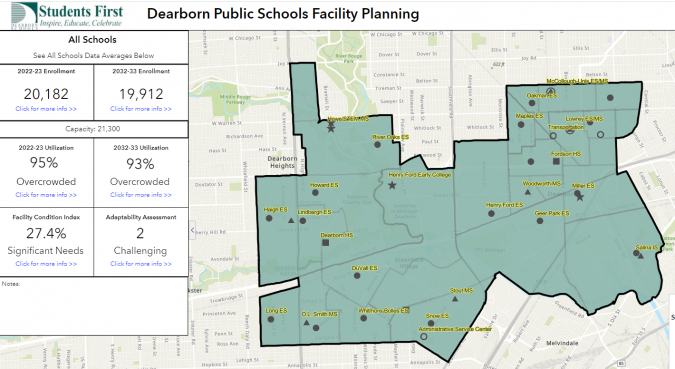A report presented to the Dearborn Public Schools Board of Education during a special meeting on Tuesday, March 21, 2023 showed a need for major investments in buildings in the district over the coming decades.
Representatives from Fielding International explained that their firm used a few factors in evaluating 31 district school buildings including the need for deferred maintenance, adaptability of the structure for projected future learning needs, and building utilization.
For facility conditions, none of the buildings rose to the level of immediate concern. However, almost half the buildings – 15 schools – were recommended for eventual replacement over the 30 year perspective included in the report. If replacement is not feasible, buildings could also be renovated but it would be more difficult and costly to redesign them to meet forward thinking classroom designs, the Fielding representatives said.
“Do not expect that these buildings are on the way out,” cautioned Board President Jim Thorpe.
The list of buildings recommended for replacement includes all of the district’s historic buildings. According to the report, the top priority schools in alphabetical order are DuVall Elementary, Henry Ford Elementary, Howard Elementary, Lindbergh Elementary, Lowrey K-8, Maples Elementary, McDonald Elementary, Salina Intermediate, Whitmore Bolles Elementary, and Woodworth Middle. Other schools also recommended for eventual replacement include Fordson High, Long Elementary, Nowlin Elementary, Oakman Elementary, and River Oaks Elementary.
Understanding the historical importance some schools have in the community, Fielding also included a fourth index, Historical Significance, in their report.
As part of the report, Fielding International created an interactive map with information about each school in the district. That map is available to the public on the district’s Facilities Planning website. By clicking on different schools, community members can learn more about the building including the attendance area, current enrollment, projected enrollment, capacity, utilization or overcrowding, and Fielding’s Facility Condition Index score and Adaptability rating for that school.
Fielding International’s presentation to the board is also on the Facilities website. A separate report shows the financial figures used to determine the Facility Condition Index for each school. In simple terms, the index compares the cost of the work a building will need in the next 10 years to the expected construction cost to build a new school. The comparison does not include related costs such as buying property or furniture or technology for the new building.
With information about each building now presented to the Board of Education, Fielding International’s next steps will be to develop two scenarios for how the district could move forward in addressing infrastructure concerns. Those scenarios will be presented to the public to gain feedback and to refine a plan for moving forward. The initial scenarios are expected to be ready to present later this spring. Those scenarios will be district wide overviews; plans regarding specific buildings would be developed later, said James Seaman, a partner with Fielding International.
“A plan that you create is not going to be set in stone for the next 30 years. You are going to have to continue to communicate with your community,” Mr. Seaman said during the meeting.
“The big takeaway is there is definitely a significant need here in Dearborn that is going to require a significant investment and it is going to take time to work through it,” Seaman added later.
As part of the study, Fielding hired Cropper GIS to create a report with 10-year enrollment projections for each school and the district.
That report showed the district’s official kindergarten to 12th grade enrollment declining slightly and then holding at just under 20,000 students.
Enrollment and overcrowding figures can be confusing on two fronts.
First, the figures do not include 640 students enrolled in the Great Start Readiness Program (GSRP). The district provides the free preschool program in 14 schools. As preschool students, those pupils do not count in the district’s official enrollment figures. GSRP is only allowed 16 students per classroom, whereas overall elementary classrooms in the district average 22 students each. Trustees also noted that Gov. Gretchen Whitmer has proposed making free preschool universal in the next several years, which could bring hundreds of more students to the district.
Secondly, high school enrollment and utilization is based on each student’s primary school, but more than 1,000 high school students spend at least part of their day outside of the building through one of several programs offered in the district. Dual enrollment, the Henry Ford Collegiate Academy, the Michael Berry Career Center, and the Dearborn Center for Math, Science and Technology all take students out of their assigned high school for somewhere between one class and the whole day.
Dearborn Public Schools hired Fielding International last fall to conduct a 30-year facility plan. The idea was, in part, to help determine which school buildings may need to be replaced.
In the spring of 2022, a citizens committee called the Visioning and Infrastructure Planning Committee recommended the board go out for a bond on the November 2022 ballot to address facility needs in the district. The board requested a facilities study to provide a better understanding and a framework for long-term facility planning.
Related documents
Fielding International’s March 21, 2023 report to the board

